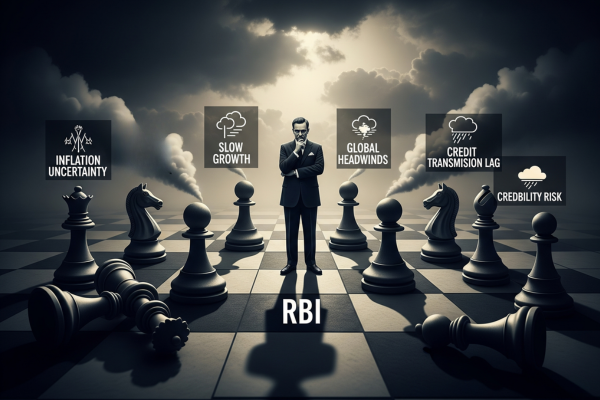.png)
RBI’s Premature Stance, Goalpost Shift May Haunt It on Growth
Trump’s tariff assault highlights why the RBI should have stayed accommodative, aiding transmission and preserving flexibility for future shocks.

August 6, 2025 at 10:56 AM IST
The Reserve Bank of India’s latest policy review confirms what markets had begun to suspect since June: the easing cycle is over. This conclusion does not arise from any sudden deterioration in inflation dynamics, but from a shift in policy stance that now appears increasingly premature. By formally shifting its stance from accommodative to neutral two months ago, the RBI has boxed itself in, dulled the impact of earlier rate cuts, and left little room to respond if growth falters in the months ahead.
The policy statement released today kept the repo rate unchanged at 5.50%, a widely anticipated outcome. What unsettled markets was the tone. The central bank’s narrative has shifted firmly toward vigilance on core inflation, with model-based projections pointing to headline CPI inflation rising toward 5% in the coming year. That caution emerges even as headline consumer price inflation has collapsed to 2.1%, its lowest level in six years, aided by food deflation and benign commodity prices.
This pivot is occurring just as the global environment is becoming more challenging.
President Donald Trump’s 25% tariff on Indian goods, coupled with the threat of a 100% surcharge linked to energy trade with Russia, represents a significant new external headwind. India’s services exports, which have cushioned its trade balance and underpinned growth, are now exposed to demand risks if global conditions deteriorate further.
The result is a central bank that appears more focused on forward-modelled inflation risks than on emerging growth realities, even as the balance of risks tilts in the opposite direction.
Transmission Blunted
The stance change in June was not a mere formality. It has had tangible effects on how monetary policy transmits through markets. Since February, the RBI has front-loaded 100 basis points of rate cuts and announced a 100-basis-point reduction in the cash reserve ratio, aimed at injecting ₹2.5 trillion into the banking system. These moves were intended to cushion the economy against global shocks and spur domestic demand.
But monetary policy operates through expectations as much as through actual rate moves. A continued accommodative stance would have signalled that the RBI remained growth-focused and retained flexibility to ease further if conditions worsened. That signal alone could have encouraged bond markets to extend their rally, lowering term premiums and easing borrowing costs across the system.
Instead, the shift to neutral told markets that the easing cycle was effectively over, even though both rate cuts and hikes are theoretically possible under a neutral stance.
The 10-year government bond is at 6.40%, 20 basis points higher than its level the day before the RBI announced its 50-bps rate cut, along with stance tightening. The spread between the repo rate and the 10-year bond has risen to almost 90 basis points from 20 basis points before the June policy.
The downward momentum in borrowing costs slowed, and banks, already flush with liquidity, became more cautious about deploying funds in a demand-constrained economy. The credit channel, instead of accelerating, has remained patchy, with households and firms still hesitant to borrow.
By closing the window too early, the RBI has inadvertently blunted the impact of its own easing. The rate cuts and liquidity injections are still working through the system, but without supportive guidance, they are unlikely to deliver their full potential boost to growth.
Growth Threats
The domestic growth picture is more uneven than headline projections suggest. Real GDP growth for 2025-26 is officially forecast at 6.5%, supported by an above-normal monsoon, rising capacity utilisation, and sustained government capital expenditure. Yet high-frequency data show fragile household consumption, slowing industrial output, and muted private investment.
Layered onto this is the external shock of Trump’s tariff war. The new 25% levy on Indian goods is already forcing exporters to reassess markets, while the threatened surcharge on energy imports from Russia could raise costs and disrupt supply chains. India’s services exports, particularly software and business process outsourcing, face their own risks if global clients retrench in response to rising protectionism.
The macroeconomic backdrop, therefore, demands agility. A central bank maintaining an accommodative stance would have had the flexibility to respond to these evolving challenges. Instead, the stance change has signalled that policy support is exhausted, constraining expectations and limiting room for manoeuvre.
Core inflation, at 4.4%, remains the RBI’s lodestar. The projection of headline inflation rising to 5% in early 2025-26 is being treated as a call to caution. Yet much of that projected increase is driven by base effects rather than new demand pressures. Food inflation remains subdued, global energy prices are contained, and domestic wage growth is moderate. A vigilant posture on inflation is defensible, but locking it into the stance risks overcorrecting at a moment when growth fragility is the more immediate concern.
It is expected that US tariffs could prove to be disinflationary for the rest of the world.
Central banks do not lose credibility by being patient. They lose it by boxing themselves into positions they later have to abandon.
Credibility at Risk
The real danger in the June stance change is not that it was hawkish, but that it was premature. It has left the RBI with limited room to surprise constructively if growth weaken or trade disruptions intensify. Should the economy undershoot expectations, the central bank would need to reverse its stance before resuming easing, a move far more consequential for market confidence than simply retaining an accommodative posture would have been.
This credibility cost matters because expectations are central to monetary transmission. Markets respond not only to actual policy moves but also to the trajectory they imply. Abrupt shifts, such as front-loading cuts and then pivoting to caution, leave investors second-guessing the central bank’s framework. That uncertainty feeds into volatility across bond yields, currency markets, and risk assets.
There is also a policy asymmetry worth noting. Fiscal policy remains conservative, with government spending carefully managed and deficit targets closely guarded. That places the burden of cyclical support squarely on monetary policy. Yet by front-loading easing and closing the door on further cuts, the RBI has effectively stepped back just as fiscal support is constrained. The mismatch raises the risk of a slower response to growth shocks and complicates the broader macroeconomic policy mix.
Patience and sequencing are as vital to central banking as the headline rate itself. By pacing its easing more gradually and maintaining an accommodative stance, the RBI could have sustained market expectations, aided transmission, and retained flexibility to respond as new risks emerged.
Instead, the central bank now finds itself in a bind: headline inflation is benign but policy signalling has hardened, growth risks are rising but room for manoeuvre is limited, and credibility is tethered to a stance that may soon need revisiting.
Central banks earn trust not by predicting every turn in the cycle, but by preserving the capacity to act when conditions shift. In tightening its stance too soon, the RBI has traded that capacity for a sense of closure. The cost of that decision will become evident if growth stumbles and the central bank discovers that its strongest card has already been played.




